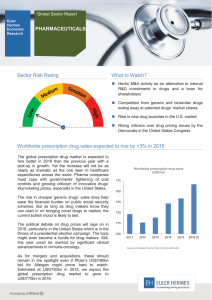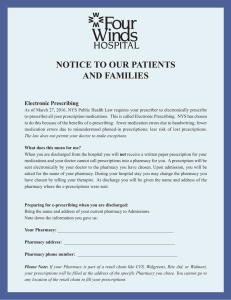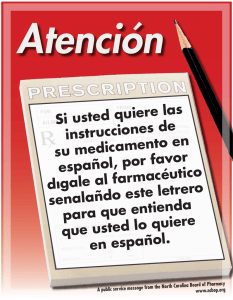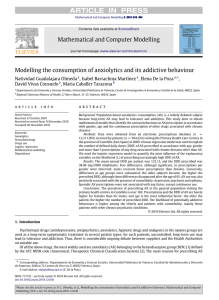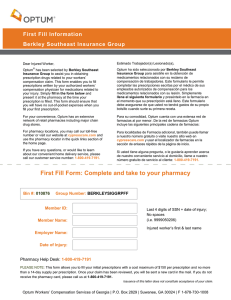Pharmaceutical Validation and Error Detection in the Prescription of
Anuncio
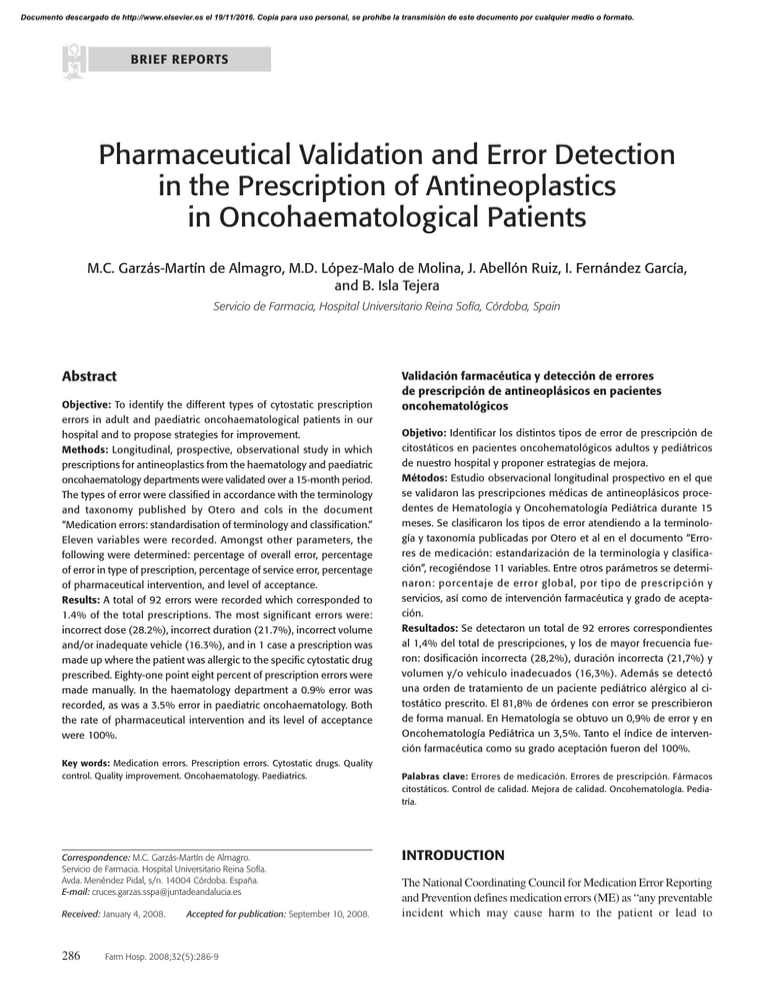
Documento descargado de http://www.elsevier.es el 19/11/2016. Copia para uso personal, se prohíbe la transmisión de este documento por cualquier medio o formato. BRIEF REPORTS Pharmaceutical Validation and Error Detection in the Prescription of Antineoplastics in Oncohaematological Patients M.C. Garzás-Martín de Almagro, M.D. López-Malo de Molina, J. Abellón Ruiz, I. Fernández García, and B. Isla Tejera Servicio de Farmacia, Hospital Universitario Reina Sofía, Córdoba, Spain Abstract Objective: To identify the different types of cytostatic prescription errors in adult and paediatric oncohaematological patients in our hospital and to propose strategies for improvement. Methods: Longitudinal, prospective, observational study in which prescriptions for antineoplastics from the haematology and paediatric oncohaematology departments were validated over a 15-month period. The types of error were classified in accordance with the terminology and taxonomy published by Otero and cols in the document “Medication errors: standardisation of terminology and classification.” Eleven variables were recorded. Amongst other parameters, the following were determined: percentage of overall error, percentage of error in type of prescription, percentage of service error, percentage of pharmaceutical intervention, and level of acceptance. Results: A total of 92 errors were recorded which corresponded to 1.4% of the total prescriptions. The most significant errors were: incorrect dose (28.2%), incorrect duration (21.7%), incorrect volume and/or inadequate vehicle (16.3%), and in 1 case a prescription was made up where the patient was allergic to the specific cytostatic drug prescribed. Eighty-one point eight percent of prescription errors were made manually. In the haematology department a 0.9% error was recorded, as was a 3.5% error in paediatric oncohaematology. Both the rate of pharmaceutical intervention and its level of acceptance were 100%. Key words: Medication errors. Prescription errors. Cytostatic drugs. Quality control. Quality improvement. Oncohaematology. Paediatrics. Correspondence: M.C. Garzás-Martín de Almagro. Servicio de Farmacia. Hospital Universitario Reina Sofía. Avda. Menéndez Pidal, s/n. 14004 Córdoba. España. E-mail: [email protected] Received: January 4, 2008. 286 Accepted for publication: September 10, 2008. Farm Hosp. 2008;32(5):286-9 Validación farmacéutica y detección de errores de prescripción de antineoplásicos en pacientes oncohematológicos Objetivo: Identificar los distintos tipos de error de prescripción de citostáticos en pacientes oncohematológicos adultos y pediátricos de nuestro hospital y proponer estrategias de mejora. Métodos: Estudio observacional longitudinal prospectivo en el que se validaron las prescripciones médicas de antineoplásicos procedentes de Hematología y Oncohematología Pediátrica durante 15 meses. Se clasificaron los tipos de error atendiendo a la terminología y taxonomía publicadas por Otero et al en el documento “Errores de medicación: estandarización de la terminología y clasificación”, recogiéndose 11 variables. Entre otros parámetros se determinaron: porcentaje de error global, por tipo de prescripción y servicios, así como de intervención farmacéutica y grado de aceptación. Resultados: Se detectaron un total de 92 errores correspondientes al 1,4% del total de prescripciones, y los de mayor frecuencia fueron: dosificación incorrecta (28,2%), duración incorrecta (21,7%) y volumen y/o vehículo inadecuados (16,3%). Además se detectó una orden de tratamiento de un paciente pediátrico alérgico al citostático prescrito. El 81,8% de órdenes con error se prescribieron de forma manual. En Hematología se obtuvo un 0,9% de error y en Oncohematología Pediátrica un 3,5%. Tanto el índice de intervención farmacéutica como su grado aceptación fueron del 100%. Palabras clave: Errores de medicación. Errores de prescripción. Fármacos citostáticos. Control de calidad. Mejora de calidad. Oncohematología. Pediatría. INTRODUCTION The National Coordinating Council for Medication Error Reporting and Prevention defines medication errors (ME) as “any preventable incident which may cause harm to the patient or lead to Documento descargado de http://www.elsevier.es el 19/11/2016. Copia para uso personal, se prohíbe la transmisión de este documento por cualquier medio o formato. Garzás-Martín de Almagro MC et al. Pharmaceutical Validation and Error Detection in the Prescription of Antineoplastics in Oncohaematological Patients inappropriate use of medications.” These incidents may be related to professional practice, products, procedures, or systems including errors in prescribing, communicating, labelling, bottling, naming, preparing, dispensing, distributing, administering, educating, following-up, and using.1 An error may be incurred at any stage in the drug treatment process for Antineoplastic ME, a high risk drug,2 (while prescribing, transcribing, preparing, and administering). Prescription errors are described as one of the most significant reasons for ME, and antineoplastics are among the most implicated of drug treatment groups.3 In any medication stage, there can be serious consequences for patients due to toxicity and at times a narrow therapeutic margin. Our group, the Spanish Group for the Development of Oncological Pharmacology (GEDEFO), developed a consensus document for preventing ME in chemotherapy, and in this, the minimal information the prescription should contain is communicated.4 With this, pharmaceutical validation could be considered an essential process for detecting possible prescription errors. The objective of this study is to identify different types of cytostatic prescription errors for haematological patients and for Paediatric Oncohaematology patients in our hospital, and to propose improvement strategies. METHODS The study was carried out in a tertiary university hospital with 1306 beds, and antineoplastics preparation was centralized in the pharmacy department. All prescriptions were validated by a single pharmacist (by using the Oncofarm® computer program, where chemotherapy protocols which are unanimously agreed upon by the prescribing clinical departments and used in the centre may be accessed), who collected data, contacted the doctor, and designated the type of error. Prescriptions from Medical Oncology were not included because their review, validation, and preparation for subsequent dispensation are carried out in a different building within the hospital complex and by a different team of pharmacists. A longitudinal, prospective, observational study was designed with 15 months of duration (May 1, 2006 to August 31, 2007, except July 2006). Data collection was carried out using specific forms designed for such a study. Detection of each ME meant that the prescribing doctor would be contacted and a pharmaceutical intervention would be done before preparation and dispensation. To assign the type of error, the terminology and taxonomy published by Otero et al5 (who used the Ruiz-Jarabo research group) were used. This was published in the document “Medication Errors: Standardisation of Terminology and Classification.” Also, the type of prescription (manual or printed), location, age, and sex of patients were recorded. The number of treatment orders (TO), validated prescriptions, patients, ME, error opportunities, error frequency, pharmaceutical interventions, and percentage of successful interventions were recorded. The omission of anthropometrical data was not considered, nor was ME related to supportive therapy prescriptions. The omission of the type or volume of vehicle was not considered an error. RESULTS During the study period, a total of 3755 TO were reviewed, and 6741 chemotherapy prescriptions were validated (prescription = each distinct cytotoxic active ingredient indicated on the treatment order), which correlated to a total of 252 patients (217 adults and 35 paediatric patients) treated by the Haematology Department (86.1% of prescriptions) and by Paediatric Oncohaematology. Fifty-three point three percent of prescriptions were for inpatients, and the rest were for outpatients. For adult inpatients, there was a prescription error rate of 43% and 18% for outpatients (overall error rate of 61%). Thirty-eight point six percent of patients were children ≤16 years (median, 4 years [1-16]), and the rest had a median age of 51 years (18-85). Fifty-six point eight percent of the TO errors were prescribed to male patients. A total of 92 ME were detected (1.4% of total prescriptions). The percentage of errors by department was 0.9% for Haematology and 3.5% for Paediatric Oncohaematology. Error frequency was calculated as that of Alcácera et al,6 and a value of 0.12 was recorded. The number of opportunities for error was 74 151. Table shows the types of errors analyzed and their distribution, and errors corresponding to incorrect dosage, treatment duration, and inadequate volume are significant because of their frequency. Dosage errors were distributed into 3 levels: overdosage (65.5%), underdosage (15.3%), and extra dosage (19.2%). The antineoplastic most frequently seen with errors was vincristine, both due to omission (25%) and dosage (19.2%); followed by intravenous cytarabine and teniposide (16.6%, respectively); and actinomycin-D, bortezomib, and mitoxantrone Table. Type of Medication Errors and Their Distribution Type of Error Incorrect dosage Treatment duration Volume Dose or medicine omission Administration frequency Administration speed Wrong patient Wrong medication Vehicle Incorrect treatment plan Route of administration Total Number of Errors Percentage of Errors 26 20 13 12 8 4 3 2 2 1 1 92 28.26 21.73 14.13 13.04 8.69 4.34 3.26 2.17 2.17 1.08 1.08 100 Farm Hosp. 2008;32(5):286-9 287 Documento descargado de http://www.elsevier.es el 19/11/2016. Copia para uso personal, se prohíbe la transmisión de este documento por cualquier medio o formato. Garzás-Martín de Almagro MC et al. Pharmaceutical Validation and Error Detection in the Prescription of Antineoplastics in Oncohaematological Patients (11.5%, respectively). An erroneous prescription of Escherichia coli asparaginase given to a child allergic to this cytostatic was detected. This was particularly significant given its potential seriousness. ME due to incorrect treatment duration reached 21.7%, and 75% of these should have been shorter treatment duration. Errors due to the type and/or volume of vehicle constituted 16.3% of total errors. Low volume was prescribed in 60% of cases. Eighty-one point eight percent of treatments in Haematology were prescribed in manual format, and 100% were prescribed in Paediatric Oncohaematology. Pharmaceutical intervention was carried out in 100% of cases after error detection, and 100% of these were accepted by the prescriber. With classification based on seriousness of harm caused, all errors were classified in category B (error with no harm), according to the Ruiz-Jarabo et al5 classification. Errors were detected and resolved in the pharmacy department before preparation and dispensation, and patients were not impacted. DISCUSSION In our study, only the ME detected in parenteral cytostatic prescriptions from the departments of Haematology and Paediatric Oncohaematology were taken into account, and ME which could have been taken from Medical Oncology were not taken into account, due to a different distribution of functions and the physical structure where these are carried out. Because of these factors, it would be appropriate to compare our study with others which analyze similar populations and use a similar taxonomy and methodology7-10 (some of these studies also do not include errors detected in supportive therapy). Our error frequency is lower than that obtained by Aguirrezabal et al,10 but even though they used the same methodology for calculation, they considered the omission of anthropometric data, the doctor’s signature, diagnosis, and also patient location as errors, all of which were not considered errors in this study. Regarding error percentages found in Paediatric Oncohaematology, our study found similar data to those by Cilveti-Sánchez et al7 for paediatric patients. Regarding error distribution by type, erroneous dosage was the most frequent ME and was inferior to that found by other authors.8,10,11 Secondly, errors of incorrect treatment duration were similar to that found by Goyache et al,11 and errors related to volume and/or inadequate vehicle were fewer than those found by other authors.7,10,12 For prescription type, an inferior percentage of errors was seen for outpatient haematological patient prescriptions than for inpatient prescriptions. This could be because we have worked with prescribing clinics in Haematology Outpatient Services in the preparation of pre-printed TO which facilitated the prescription 288 Farm Hosp. 2008;32(5):286-9 process. This analysis was not carried out on Paediatric Oncohaematology, considering they only produced manual prescriptions. Regarding international publications, Gandhi et al13 carried out a prospective study which identified and classified ME for adult and paediatric oncohaematological outpatients, and obtained errors in 3% of medications. Our study included outpatients and inpatients (adults and paediatric patients), and found an inferior percentage of errors. Although the percentage of prescriptions in the Haematology Department, along with its percentage of errors compared with total prescriptions was superior to that of Paediatric Oncohaematology, it is important to point out that the percentage of errors per department was superior in Paediatric Oncohaematology, adding particular relevance to the interventions made in paediatrics. Data collection, contact with the prescribing doctor, and error classification were always carried out under the same criterion by the same pharmacist, and this was carried out during a long follow-up period in which a high number of prescriptions were validated. These aspects could favourably influence internal validity of the study. Furthermore, the study included the oncohaematological paediatric population, for whom there are few similar studies carried out in our specialty. The carrying out of these types of studies can be highly useful for identifying factors for improving quality in the prescription of cytostatics. Although the overall percentage of errors is relatively low (1.4%), it is apparent that through the pharmaceutical validation process, certain errors have been prevented from reaching the patient. Therefore this validation process could be regarded as an essential step within the overall system of prescription, preparation, and administration of antineoplastics in the hospital. In Haematology, a system of electronic prescription has been established as an improvement strategy and for avoiding detected errors.2 Its use would be beneficial if expanded to other involved departments and if subsequent studies were carried out for comparison of results. References 1. ASHP Guidelines on Preventing Medication Errors with Antineoplastic Agents. Am J Health Syst Pharm. 2002;59:1648-68. 2. ISMP: ISMP Medication Safety Self AssessmentTM. Huntingdon Valley, PA: Institute for Safe Medication Practices; 2008 [cited, Apr 1,2008]. Available from: http://www.ismp.org 3. Climente Martí M, Jiménez Torres NV. Manual para la atención farmacéutica. 3rd ed. Valencia: IVADIS; 2004. 4. Grupo Español para el desarrollo de la Farmacia Oncológica (GEDEFO). Prevención de errores de medicación en quimioterapia; 2001 [cited Nov 9, 2007]. Available from: http://www.amgen.es/amgen2/grupos/ Errores_medicacion.htm 5. Otero MJ, Codina C, Tamés MJ, Pérez M; en representación del grupo de trabajo Ruiz-Jarabo 2000. Errores de medicación: estandarización de la terminología y clasificación. Resultados de la Beca Ruiz-Jarabo 2000. Farm Hosp. 2003;27:137-49. Documento descargado de http://www.elsevier.es el 19/11/2016. Copia para uso personal, se prohíbe la transmisión de este documento por cualquier medio o formato. Garzás-Martín de Almagro MC et al. Pharmaceutical Validation and Error Detection in the Prescription of Antineoplastics in Oncohaematological Patients 6. Alcácera MA, Pérez-Landeiro A, Panadero MI, Rebollar E, Idoipe A, Palomo P. Errors detected in the prescriptions of antineoplastic agents and their severity level. Eur Hosp Pharm. 2001;7:20-3. 7. Cilveti-Sánchez U, Agustín MJ, Casajús MP, Arrieta R, Idoipe A, Palomo P. Errores potenciales en prescripción de citostáticos parenterales: validación farmacéutica. Rev OFIL. 2006;16:15-24. 8. Díaz-Carrasco MS, Pareja A, Yachachi A, Cortés F, Espuny A. Errores de prescripción en quimioterapia. Farm Hosp. 2007;31:161-4. 9. Vuelta Arce M, Calabuig Muñoz M, Jornet Montaña S, Canadell Vilarrasa L, Riera Sendra G, Chumillas C, et al. Evaluación de la calidad en el proceso de utilización de fármacos peligrosos: prescripción y preparación. Farm Hosp. 2005;29:119-25. 10. Aguirrezábal A, Álvarez M, Yurrebaso J, Vilella ML, Elguezabal I, Goikolea FJ, et al. Detección de errores en la prescripción de quimioterapia. Farm Hosp. 2003;27:219-23. 11. Goyache MP, Vicario MJ, García MP, Cortijo S, Esteban MJ, Herreros A. Errores de prescripción en citostáticos: análisis de sus causas y propuestas para prevenirlos. Farm Hosp. 2004;28:361-70. 12. Sánchez Gómez E, Fernández Lisón LC, Giménez Castellanos J, Martín Fernández N, Marín Ariza I, Ynfante Milá JI. Evaluación de errores en prescripciones antineoplásicas. Seguim Farmacoter. 2003;1:105-9. 13. Gandhi TK, Bartel SB, Shulman LN, Verrier D, Burdick E, Cleary A, et al. Medication safety in the ambulatory chemotherapy setting. Cancer. 2005;104:2477-83. Farm Hosp. 2008;32(5):286-9 289
